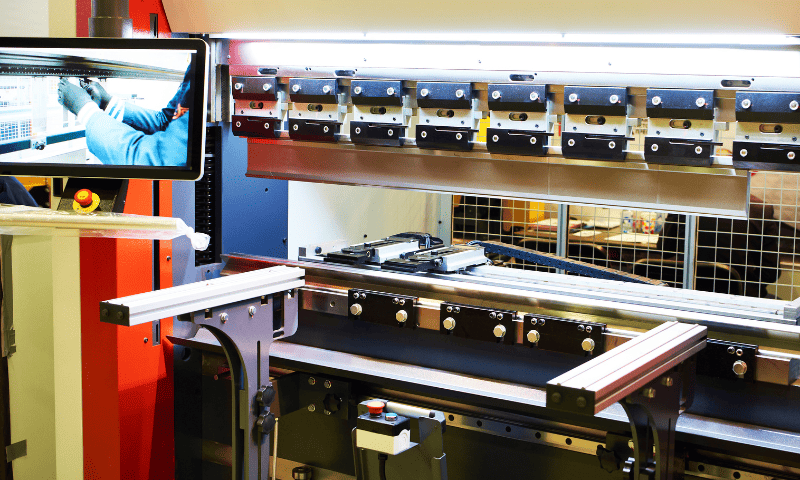In today’s manufacturing landscape, bending machines are indispensable tools, shaping raw materials into precise forms with unmatched efficiency. From crafting angular designs into sheet metal to curving robust steel tubes, these machines are the backbone of countless industries, including automotive, construction, HVAC and more.
However, finding the right bending for your business can be a challenging process.
This article simplifies the basics of metal bending machines and compares their various types, applications, and benefits.
What are Bending Machines?
Bending machines are metal processing tools that bend, shape, and curve parts at various angles. The bending process is a cold working technique that gently stretches the metal to the desired angle. Occasionally, some machine oil or lubricant is required to help reduce the resistance between the workpiece and the die press.
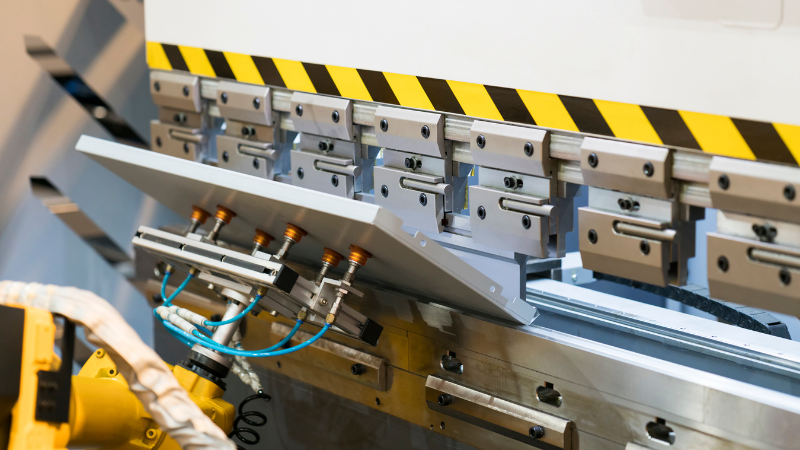
The key to a high-quality bending machine is the even distribution of pressure along the surface of the metal workpiece. Equal and consistent force reduces the risk of metal fatigue and accidental fracture.
Bending machines have near-universal metal compatibility. They can bend everything from soft metals like copper and aluminum to tough ones like stainless steel and titanium.
How Does a Bending Machine Work?
The machine type primarily determines the basic working principle of a bending machine. Press brake-type bending machines use a punch-and-die approach to shape sheet metal. Contrarily, a pipe-bending machine uses a set of two to three spinning rollers that stretch and bend the pipe.
Later, as we get into the details of the different bending machines, we will see that the general principle remains the same. To initiate the bend, the metal workpiece needs two controlled opposing forces at a concentrated point.
We discuss the various metals being processed in more detail later in the article.
Ready to Get Your Own Bending Machines?
Boost your operations with Baison Laser's advanced, customized technology!
Different Types of Bending Machines
Whether it’s small pipes, large tubes, rebar, thick metal plates, or regular sheet metal, a bending machine is available for all applications.
Each bending machine has specific functions that cater to the various metal fabrication processes.
1. Pipe Bending Machine (Tube Bending)
A pipe bending machine is designed to bend cylindrical shapes so that the pipe’s internal diameter remains consistent throughout its entire length. Although such machinery is commonly called a pipe bending machine, it can bend other tube shapes like rectangular or square tubes, solid rods, or metal channels.
Parameters
Pipe bender parameters vary from machine to machine. Most industrial machines have the following parameters.
- Outer Diameter Range – 0.5 inches to 72 inches
- Bending Radius – 1.5D – 20D (D=Diameter)
- Max Bending Angle – 270°
- MAX Wall Thickness – 5 inches
Types of Pipe Bending Machines
Pipe bending machine work can be categorized into a few types based on manual or automatic configurations and their different feature sets. There are four basic types of pipe-bending machines.
- Rotary Draw Bending Machine (Stretch Bending)
- Compression Bending Machine
- Ram Bending Machine
- Roller Bending Machine
Process
- A rotary draw pipe bender machine clamps the metal tube along a circular bending die. A lever pulls the tube along the die, curving it in the process. This technique best suits small to medium-diameter pipes, tubes, and rods.
- A compression pipe bender uses compressive force to shape the metal tube. It has two sideways pressure pistons that press the front and back of the tube against a circular bending die. Compression bending is preferred for its ability to bend large pipes with ease.
- A ram pipe bender is the opposite of compression bending. It uses a ram to apply pressure to the center of the bend point instead of applying force to the pipe’s surrounding area. This technique can bend pipes at sharper angles.
- The roller pipe bender tool involves three or more rollers that spin in opposite directions. As the metal pipes move through the machine, the rollers slowly bend them to one side. The distance between the rollers helps determine the angle of the bend. Repeated passes through the machine are recommended for the highest quality bends, with each pass increasing the bending angle.
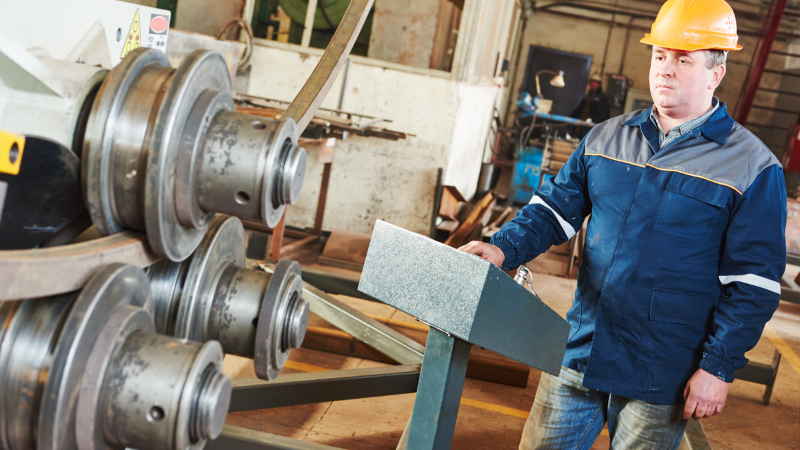 Roller pipe bender machines yield the most smooth and consistent bends. These are also the only machines capable of bending a pipe along an even circular path. The other pipe bending tools are better suited to quick applications and multiple bends.
Roller pipe bender machines yield the most smooth and consistent bends. These are also the only machines capable of bending a pipe along an even circular path. The other pipe bending tools are better suited to quick applications and multiple bends.
Applications
A pipe bending machine is used in several professional industries. Bending pipes is always challenging as the inner side of the bend can easily collapse and crimple.
- Construction
- Shipbuilding
- Furniture and Architecture
- Handrail Manufacturing
- HVAC Tubing
- Plumbing & Pipe Fittings
- Manufacturing Exhaust Pipes
Ready to Get Your Own Bending Machines?
Boost your operations with Baison Laser's advanced, customized technology!
2. Plate Rolling Machine
A plate roll bending machine is an industrial tool designed to curve large metal plates into a cylindrical or semi-cylindrical path. Even entry-level plate rollers are usually the size of a truck and are either fully or semi-automatic.
A standard industrial plate rolling machine can cold roll up to 3-inch thick metal plates. The same machine can even bend 4-inch thick plates using hot rolling.
Parameters
Here are some common operation parameters of plate rolling machines.
- Workpiece length – 12ft. 144 inches.
- Workpiece Width – As Per Roller Length
- Workpiece Thickness – 3 inches (Cold Rolling) or 4 inches (Hot Rolling)
- Maximum Rolling Diameter – 12 ft.
Process
The general design of a plate rolling machine remains consistent across various models. It uses a three-roller system arranged in a pyramid shape. The top roller applies downward force, and the bottom two rollers apply counter-reaction, keeping the metal plate securely clamped in the middle.
Powerful motor control systems monitor and adjust the distance between the top and bottom rollers. Like pipe bending machines, multiple passes through the machine are required for sharper bends.
Applications
- Petrochemical and Oil & Gas – Containment Tanks
- Aerospace and Aviation – Rocket Exterior
- Automotive and Transportation – Tank Truck
- Mining and Heavy Equipment – Underwater Piping
- Shipbuilding and Marine Industry
- Construction and Architecture
3. Sheet Metal Bending Machine
A sheet metal bending machine is a powerful tool for shaping flat metal sheets into complex shapes and structures. These bending tools can bend, curve, and fold metals at various angles for a sharp, angular, or rounded finish.
Sheet metal bending is always used in conjunction with a metal cutting technique. For example, fiber laser cutting machines are used to cut out the basic shape, and bending machines are used to shape it into a 3D design.
Similar to pipe rolling, several types of sheet metal bending techniques exist.
- Punch and Die Bending Process
- Single Die Beading Process
- Two Die Shaping Process
- Roller Bending Process
Parameters
- Sheet Thickness Range – 0.08 to 0.24 inches
- Max Sheet Length – Machine Size Dependent
- Max Sheet Width – Machine Size Dependent
Process
- In punch and die sheet metal bending, the metal sheet is squished between a powerful piston and two counter supports (die) to create bends.
- Single-die beading involves pushing the metal sheet into a circular cavity die, shaping the sharp edge of the metal sheet into a rounded edge.
- Two-die shaping involves sandwiching a metal sheet between a positive and negative die. The upper and lower dies mirror one another and fit together perfectly when closed.
- Roller bending sheet metal involves three rollers that curve metal sheets. Sheet metal rollers are smaller than plate rolling machines.
Applications
- Electronic Enclosure Manufacturing
- Automotive Body Panels
- Metal Hemming
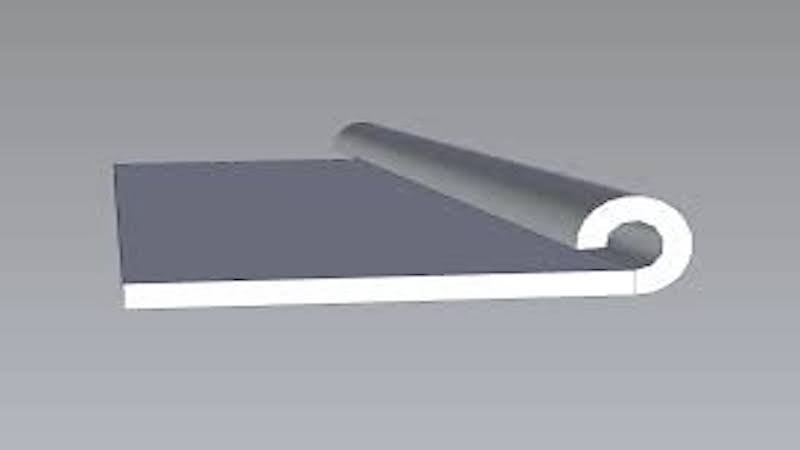
- Refrigerators
- Brackets
- Various Industrial Applications.
Heming is the process of reinforcing metal edges and hiding the burs.
4. Press Brake Machine
Press brake machines are specialized industrial metal plate and sheet fabrication tools. They utilize a punch-and-die approach to bending and have robust brakes that stop the punch from fully making contact with the die underneath.
A press brake bending machine can output incredible downward force, allowing for thick metal plate processing. It also supports different braking systems that have their own advantages.
- Hydraulic Brakes
- Electric Brakes
- Hybrid Electric Brakes
- Syncro Brakes
- Nut-Stop Brakes
Electric brakes are the highest-performing option and are generally preferred for their near-silent operation.
Parameters
- Sheet Thickness Range – 0.24 to 0.80 inches
- Max Sheet Length – Machine Size Dependent
- Max Sheet Width – Machine Size Dependent
Process
A matching punch and die set is attached to the press brake machine. Bending instructions are fed to a computer system that determines the punch’s compressive force and braking point.
Press brake machines come with a diverse range of punch and die tools that determine the bend’s angle, shape, and finish.
Applications
Press brake machines are used in various industries for different metal-forming applications.
- Heavy Machinery
- Construction
- Automotive
- Ship Building
- Oil and Gas
- etc.
Ready to Get Your Own Bending Machines?
Boost your operations with Baison Laser's advanced, customized technology!
5. Mechanical Bending Machine
Mechanical bending refers to the use of motors, wheels, gears, or levers to initiate a compressive or tensile force on the metal workpiece. These metal bending machines can have automatic or manual operation modes.
Pipe bending and plate rolling machines are two popular examples of mechanical bending.
Mechanical bending machines have excellent accuracy and produce more consistent and sharp bends. They are primarily used for complex and intricate fabrication work.
Process
The process specifics will vary depending on the machine model and bending technique. However, the core principles remain the same.
- Manual bending machines use levers, pulleys, or gear trains to increase the efficacy of the applied force.
- Automatic bending machines use motors and mechanical actuators to apply force on the metal piece.
Applications
- Construction
- Automotive
- Plumbing
- HVAC Ducting
- Electronic Enclosures
- etc.
6. Hydraulic Bending Machine
Hydraulics is the science of using liquids to generate and transfer force. A hydraulic bending machine is more powerful and supports thicker metal plates than any mechanical option. Hydraulics are also more reliable than motors and gear trains.
Die and punch-type bending machines can have either mechanical or hydraulic actuation sources. Press Brake machine manufacturers often offer both options for the same model.
A hydraulic bending machine has more power than a mechanical one but less overall accuracy. It has a uniform force distribution, so the bend for a larger workpiece remains consistent across its length. Hydraulic machines are best suited to high-volume production runs.
Process
A piston applies a small downward force on a hydraulic cylinder, which pushes the liquid into a larger container. Hydraulic pressure is directly related to surface area. So, when the liquid enters the larger container with a higher surface area, the initial force multiplies according to the surface ratio of the two containers.
Some bending machines use a hybrid design, where the rollers are mechanically driven, but a hydraulic control system maintains the distance between the rollers.
Applications
- Aerospace and Aviation
- Automotive and Transportation
- Mining and Heavy Equipment
- Shipbuilding and Marine Industry
- Construction and Architecture
| Machine Type | Bending Power | Accuracy | Use Case |
|---|---|---|---|
| Pipe Bending | Low-Medium | Good | Pipes, Tubes, Rebar, Channels etc. |
| Plate Bending | High | Good | Metal Plates over 6mm |
| Sheet Metal Bending | Medium | Great | Metal Plates under 6mm |
| Mechanical Bending | Medium-High | Great-Excellent | High Accuracy Applications |
| Hydraulic Bending | High to Very High | Good | High Volume Production |
Ready to Get Your Own Bending Machines?
Boost your operations with Baison Laser's advanced, customized technology!
Applicable Materials for Bending Machines
Bending machines can process most metal materials with ease. Softer metals, in particular, are no problem. The material choices remain consistent whether you’re looking for a metal plate, sheet metal, or pipe bending machine.
- Iron
- Carbon Steel
- Stainless Steel
- Copper
- Aluminum
- Brass
- Titanium

Avoid particularly tough and brittle materials like heat-treated and hardened steel plates. For pipe bending machine material, wall thickness is more important than metal type. Softer metals will collapse more easily when bending pipes.
Additionally, always check the manufacturer-provided manual for the fine details.
7 Factors to Consider When Buying a Metal Bending Machine
A metal bending machine is a big investment. Choosing one that fits your business needs and makes the most out of your budget can be challenging.
So here are seven factors that are sure to make your job easier.
1. Bending Application (Metal Shape)
Outline the types of metals and shapes you’ll primarily be using: metal sheets, pipes, rebar, plates, channels, etc. If you need accurate and precise bends for those high-performance applications, consider automatic machines (CNC systems).
2. Machine Capacity
Evaluate the machine’s bending capacity in terms of thickness and length of the metal and its maximum bend diameter in case of plate rolling. Ensure it meets your current and potential future project requirements.
Larger machines are considerably more expensive due to their increased size, power, and manufacturing complexity.
3. Bending Accuracy
Bending accuracy refers to a bending tool’s ability to make bends accurately to meet your needs. Poor bending accuracy means a 90° bent pipe will have an error of one or two degrees. Look for machines with features like digital readouts, angle presets, or CNC capabilities for precise bending.
4. Ease of Use
Consider the user-friendliness of the machine, especially if you’re not highly experienced with metalworking. Features like intuitive controls, quick setup, and ergonomic design can enhance productivity and reduce errors.
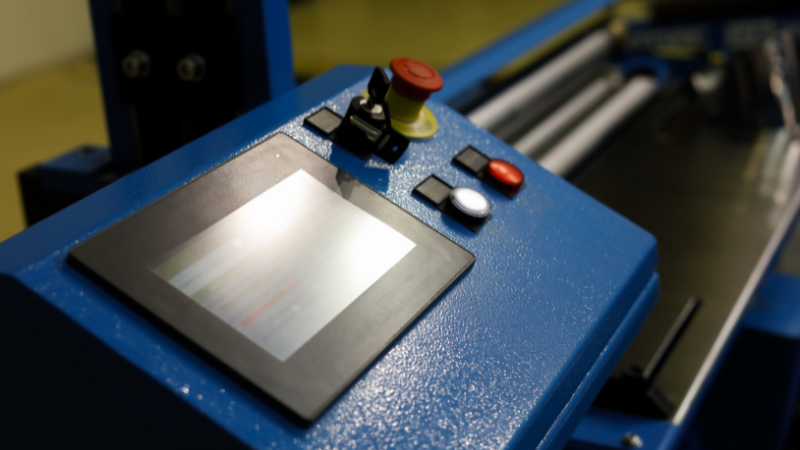
5. Warranty Specifics
Review the warranty documentation provided by the manufacturer. Ensure it includes essential components and addresses common issues that may arise during regular use. A comprehensive warranty can offer peace of mind and protect your investment.
Also, ask the bending tool supplier or manufacturer about their policy on accidental damage during shipping.
6. Shipping Costs
Factor in shipping expenses, especially if you purchase the machine from an overseas location. International shipping costs are all over the place. Compare shipping options and consider any additional fees associated with delivery to determine the total cost.
7. After-Sales Services
Evaluate the manufacturer’s reputation for after-sales support and customer service. This includes technical assistance, spare parts availability, and maintenance services. Reliable after-sales support can minimize downtime and extend the lifespan of your machine.
Ready to Get Your Own Bending Machines?
Boost your operations with Baison Laser's advanced, customized technology!
How to Maintain the Bending Machine?
Timely cleaning and equipment maintenance are necessary for the longevity of your machine. Here are a few simple steps you can take to keep your pipe bending machine in pristine condition.
1. Stay within the Operating Parameters
A pipe bender is designed to deal with small-diameter items. Trying to bend pipes that exceed the machine’s parameters will lead to premature wear and potentially cause serious damage.
2. Regularly Oil Your Machine
Lubrication is critical for reducing friction and preventing wear on moving parts. Follow the manufacturer’s recommendations for lubricating the machine’s components, including the bending mechanism, punch piston, rollers, and hydraulic system.
3. Keep Your Bending Machine Clean
Over time, dust and small metal bits can accumulate inside your machine. This problem accelerates when working on a factory floor with many other metal processing equipment like metal sheet & tube-integrated laser cutting machines. Use compressed air or a vacuum to remove larger bits and wipe down surfaces with a damp cloth for dust.
Keeping the machine clean also prevents corrosion and ensures smooth operation.
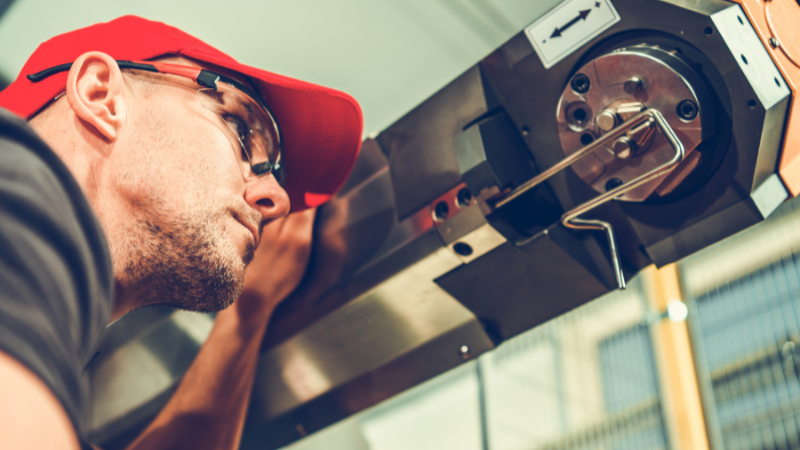
4. Check for Tool Wear
Inspect the bending tools, such as dies, punches, and mandrels, for signs of wear or damage. Replace worn-out or damaged tools promptly to maintain bending accuracy and prevent defects in the finished parts.
5. Inspect Hydraulic System
An optional maintenance factor is hydraulic system upkeep. If your bending machine is hydraulic-driven, regularly inspect the hydraulic system for leaks, damaged hoses, or worn seals. Check hydraulic fluid levels and condition, and replace or top up fluid as necessary.
Conclusion
Metal bending tools play a big part in our modern manufacturing industries. The traditional method of hammer curving parts was time-consuming and yielded poor results. Modern bending methods, like hydraulic bending and pipe rolling, have proven themselves time and time again. Pipe bending, in particular, is a necessary element for plumbing work.
Forge Your Success with Baison Laser!
Baison is an industry leader in fiber laser system manufacturing. Our diverse range of products includes everything from laser cutting, marking, and welding machines. We use state-of-the-art CNC systems to power our high-precision tools. Our new Metal Bending Machines are designed to our same exceptional quality and performance standards.
Our next-level customer support services include a FREE Application Evaluation and a FREE Customer Training Program. So, you always get the best value.
Get a Customized Quote Today! Contact us Now!

